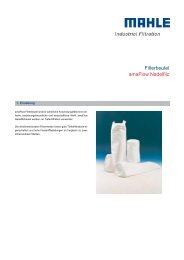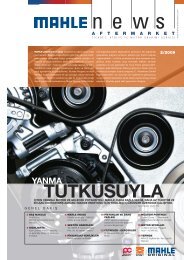English - Mahle Powertrain Ltd
English - Mahle Powertrain Ltd
English - Mahle Powertrain Ltd
You also want an ePaper? Increase the reach of your titles
YUMPU automatically turns print PDFs into web optimized ePapers that Google loves.
ProJECtSProJECtS:TURBULENT JET IGNITIONTurbulent Jet Ignition (TJI) is a highenergyignition system utilizing a prechamberignition device that enableshomogenous ultra-lean combustion,hence achieving remarkable fuel efficiencyand low engine-out NO x emissions.in order to minimize fuel consumption andreduce emissions without sacrificing enginepower and flexibility, various technologiesand strategies have been applied throughoutthe industry. downsized, boosted enginescurrently lead the fi eld in reducing drive cyclefuel consumption and minimizing Co 2 output.However, as engines are being furtherdownsized, the swept capacity can only bereduced to a certain point as the combustionis compromised and the peak effi ciencyis significantly lowered due to high boostpressures causing heavy knocking. theMaHlE <strong>Powertrain</strong> downsizing engine hasalready achieved a 30 percent fuel economybenefit from its 50 percent reduction incapacity, but following this path to furtherreductions is increasingly challenging. Butthere are still various fuel economy measuresthat can be applied to downsized enginesfor further efficiency improvements.the MaHlE tJi system is a new technology,which replaces the standard spark plug witha prechamber jet ignition assembly. insidethe tJi assembly is a small prechamber witha direct-injection (di) injector that provides asmall amount of fuel, and a spark plug toignite that charge. the prechamber is connectedto the main chamber by a number oforifi ces, which allow the jets of partially combustedproducts to ignite the main charge.the main chamber is fueled through a conventionalport or direct-injection injector.Extensive research and development hasbeen completed on a single-cylinder testengine. the single-cylinder engine features adisplacement of 0.6 liters, a bore of 88 mm,a stroke of 98 mm, a compression ratio of10.4:1, and has operated on a variety ofgasoline and alternative fuels ranging downto 60 ron fuel. the tJi system has beenable to match the speed and load of theconventional spark ignition combustion with12.5 bar BMEP and 5,500 min -1 successfully.When operating in homogeneous leanmode, the normal gasoline spark ignitionsystem has combustion limitations at λ-levelsnear to 1.4. However, the prechamber jetignition system is capable of running up toλ = 2.2 in the normally aspirated single-cylinderengine. this homogeneous lean combustionhas reduced the engine-out no x levelsas much as 99.7 percent or down to lessthan 10 parts per million. the part load fuelFuel consumption benefits with TJIeconomy has also improved by more than20 percent, with a peak thermal efficiency ofmore than 42 percent. Furthermore, the tJisystem’s combustion is much quicker thanwith standard spark ignition, enabling theengine to operate at optimum spark timingas the knock limit is extended signifi cantly.the successful single-cylinder developmentprogram carried on to a multicylinder investigation.in this case, a boosted four-cylinderengine was selected. the supercharged twoliterengine featured a lower compressionratio of 9.4:1 with a 86 mm bore and stroke.Early development work on the boostedmulticylinder engine achieved successfulresults with a lean limit close to λ = 2.5 at17 bar BMEP. no x levels measured werebetween 0.25 and 0.55 g/kWh. initial investigationswere conducted with a combinedlean and EGr strategy, which revealed thata 25 percent EGr rate improved the BSFCby up to 45 g/kWh. However, the improvementsin knock sensitivity were primarilydue to the fast burn rates, which enable improvedcombustion phasing.in conclusion, the efficiency and fuel consumptionadvantages associated with tJihave been demonstrated on multiple engines,with improvements in the region of20 percent. BSFC values below 220 g/kWhhave been measured, with a demonstratedpotential of 200 g/kWh. Further improvementsare expected with the application ofadditional combustion chamber changes andcontinued development.Emissions have also been reduced significantly,with no x reduced by more than 99percent at λ-levels greater than 2, and smokeand HC have also been maintained atequivalent levels to the baseline spark ignitionengines. the system has so far beendemonstrated at speeds of up to 5,500 min -1and BMEP levels of 17 bar.MaHlE’s turbulent Jet ignition is an excitingnew combustion system that providesgreat potential for further Co 2 emissions reductionin current downsizing engines andallows a new perspective on lean combustionfor future Co 2 challenges.Author: Hugh Blaxill14 Special Edition MAHLE Performance 2013 Special Edition MAHLE Performance 2013 15
ESEarCH and dEVEloPMEntrESEarCH and dEVEloPMEnt:SINGLE-CYLINDERHiGH-SPEEd BottoM EndA better understanding of the fundamentalcombustion processes is key todelivering ever cleaner and more fuelefficientengines. Single-cylinder engines,and specifically optical singlecylinders,have long been employed toprovide this insight. Typically, these researchengines are slow, fragile, andlargely manually controlled and thereforenot particularly well-suited to modern-dayengine research with their largenumber of controllable parameters. Toenhance its combustion research anddevelopment efforts, MAHLE <strong>Powertrain</strong>designed and built its own, fully opticalsingle-cylinder engine. This engine wasfirst installed in 2006, and a version ofit is still being utilized extensively to providevaluable insight into charge motion,mixture preparation, and combustionfundamentals.Balanced high-speed enginerecently, MaHlE <strong>Powertrain</strong> has developedits own fully balanced bottom end for usewith its single-cylinder research engines.the design brief was to provide a robust,highly modular platform to enable efficientand therefore cost-effective r&d testing.With this in mind, the fully balanced bottomend ensures that the traditionally used“seismic mass” is no longer needed, meaningthat almost any engine testbed can now beused. the MaHlE high-speed single-cylinderengine allows for quick changes of cylinderheads, pistons, and compression ratios. therobust design is able to withstand in-cylinderpressures of up to 200 bar and ensureshigh levels of testbed utilization and data. tofurther enhance effi ciency, the MaHlE FlexibleECU and its closed-loop combustion controlfeatures are used to control the engine.the engine layout is extremely modular,allowing the bottom end to form the basisfor thermodynamic, optical, and semi-opticaldiesel and gasoline engines. this makes theCorrelation of CFD simulation and PIV optical measurementsengine very versatile and its use can range Measurement techniquesfrom combustion system development, CFd Many different techniques can be employedin-cylinder air fl ow, mixing and combustion with optical engines for recording specificcorrelation to oil fi lm thickness and piston measurements. For the studies presented,ring liner friction measurements. a “grasshopperlinkage” can be included to enable ticle image Velocimetry (PiV) and laserMaHlE <strong>Powertrain</strong> has chosen to use Par-high-frequency piston measurements. oil doppler Velocimetry (ldV) methods to givepiston jets can be fl exibly confi gured and two direct measurements of air velocities andpulley locations (full speed and half speed) turbulence levels during the intake andare available to drive the cams and additional compression strokes.ancillary devices.the PiV process uses a laser sheet to illuminateparticles that fall within the plane of theMinimal levels of vibration across the completeengine speed and load envelope are laser. Several laser pulses are triggered inachieved using fully integrated, gear-driven quick succession, and software algorithmsprimary and secondary balance shafts with are used to track particles to determine theirbolt-on weights. Bores between 65 and direction and velocity, resulting in a 2d vector100 mm and strokes between 60 and 100 mm fi eld. turbulence Kinetic Energy (tKE) valuescan be accommodated. Balancing the engineallows not only higher engine speeds—can also be derived from these vectors.thermodynamic to 8,500 min -1 , optical to ldV processes utilize two intersecting laser5,000 min -1 —but is also instrumental to beams, which create an interference patterngood quality optical results.of light and dark bands within a very smallvolume. Particles traveling through this patternreflect a wave form, the frequency ofwhich is directionally proportional to thecomponent of their velocity through thesebands. Both measurement methods havetheir individual limitations, but when appliedtogether, the ldV results can be used very effectivelyto provide independent verifi cation ofthe PiV measurements and tKE calculations.Correlation to Computational FluidDynamicsthe data gathered when using the PiV andldV techniques has been compared withMaHlE <strong>Powertrain</strong>’s Computational Fluiddynamics (CFd) calculations and very encouragingcorrelations have been observed(within the limitations of both measuringsystems and the CFd code).Further work is currently being conductedtoward improving the robustness of the CFdmodeling process to give optimum run times,enhanced correlation, and a more detailedunderstanding of the effects of injector spraypatterns on turbulence levels, mixture formation,and subsequently the combustion.Author: Dave OudeNijeweme16 Special Edition MAHLE Performance 2013 Special Edition MAHLE Performance 2013 17
ESEarCH and dEVEloPMEntThermal efficiency mapfoundry was used to maintain the enginehot side at a continuous 750°C.Max. cylinder pressure (bar)new safety systems were installed in theengine test cells and rig areas to enable theengine to use hydrogen pressurized up to200 bar as the working fl uid. testing focusedon three functional areas: rig testing todevelop dry-running piston seals, a motoredengine to validate cranktrain designs,and a fi red engine for thermodynamic development.rESEarCH and dEVEloPMEnt:STIRLING ENGINEFor Solar aPPliCationSThe worldwide drive to “decarbonize” an alternative higher-effi ciency method ispower generation is driving the investmentin “green” technologies such as rors to concentrate the sun’s rays to powerConcentrated Solar Power (CSP): using mir-solar, wind, and hydro power. MAHLE a heat engine, usually a steam turbine, forstarted designing and developing a electricity generation. However, these installationsare on a large megawatt (50–150 MW)25 kW Stirling engine for use in solarpower generation applications.scale, requiring signifi cant initial capital investment.as an alternative, MaHlE has beenSolar power generation using photovoltaic considering 10–50 kW heat engines, which(PV) cell modules is very popular in the could be more suitable for smaller installations.in this size range, a Stirling heat 2–10 kW range, but suffers from low effi ciency.engineEngine speed [n/min]Stirling engine—thermal efficiency mapis more efficient than a steam turbine and sun’s heat. the four cylinders are arrangedhas the added benefit of not consuming in a square pattern using two crankshaftswater, which is a valuable resource in dry, geared together. this compact and symmetricalcylinder arrangement minimizessunny areas where solar energy offers thebest potential.heat loss and offers the best thermodynamiceffi ciency. the pistons are double-acting,the Stirling engine was invented by the with pressure above and below, and areverend robert Stirling in 1816, as an alternativeto the steam engine. it utilizes the used to connect the conrod andcrosshead with sliding gas seal isposi tive temperature difference between a piston and to seal the lowerhot working volume (typically 750°C) and a volume. Without the supportcold working volume (typically 120°C) to alternatelyheat and cool the gas and thereby CaE analysis was used ex-of previous experience or data,generating a pressure force on the piston, tensively to guide thewhich thus converts to mechanical motion. design process. thermodynamicsimulationPowered by any heat source available, ithas a wide variety of applications, from submarinesto spacecraft.developed to assist withsoftware was specifi callydefining the geometry of thein September 2009, MaHlE started the engine.project to design and develop a 25 kW Stirlingengine for use in solar power generation applications.With limited previous knowledge in two seal development rigsFour prototype engines andthe solar renewable sector, particular effort were procured for testing,was made to identify specific targets and starting in June 2011. astheir relative importance to the project. using solar energy as the heatsource is not feasible for conceptthe selected design concept employs a development, the natural gas burnerdish configuration to collect and focus the technology from the MaHlE <strong>Powertrain</strong>the fi rst concept design engine achieved amaximum power of 26 kW and 40 percentthermal efficiency in comparison to programtargets of 25 kW and 37 percent, respectively.there has also been a good correlationbetween predicted and actual thermodynamicperformance.Author: Derek WiseSolar Stirling dish18 Special Edition MAHLE Performance 2013 Special Edition MAHLE Performance 2013 19
EnGinE ControllErSEnGinE ControllErS:FLEXIBLE ECU FOR ENGINEand CoMPonEnt dEVEloPMEntTo meet the increasing challenges of to assist with the development of both newemissions, CO 2 reduction, performance, technologies and engines for clients, MaHlEand cost, engines and component technologiesare becoming ever more com-ECU” platform, known as MFE, to allow rap-<strong>Powertrain</strong> developed an in-house “Flexibleplex. This inevitably requires increasingly id software development. the hardware wascomplex control by the engine managementsystem. In the early development power and flexible input/output to meet allspecified to provide sufficient processingphase of a project, when the appropriate likely applications, including:engine management software has not yetbeen written, progress can be seriously ■ Extensive analog, digital, and powerhindered.input/output capability■ Flexible confi guration of crank/cam sensors■ direct triggering of diesel/direct-injectiongasoline solenoid injectors■ interfacing to multiple sensors andactuators■ Calculation of combustion parametersfrom in-cylinder pressure signals■ Multiple Can buses with easily confi guredmessage defi nition■ Complex exhaust gas aftertreatmentsystems■ Mechatronic components and hybridsystemsUtilizing this basic platform, MaHlE <strong>Powertrain</strong>has developed its own engine managementcode, based on extensive experiencewith various production management systems.the software was initially set up fortestbed running, but has now been developedinto a fully transient torque-based vehiclesystem. More complex features can be easilyturned off, when not required, to improveease of use during basic testing.the executable code is autogenerated fromgraphical Simulink/targetlink models, whichgreatly reduces the risk of errors and processingtime. the graphical source code alsoprovides comprehensive documentation forusers of the system.System configuration (number of cylinders,turbo or naturally aspirated, etc.) is mostlycontrolled via global system settings ratherthan altering individual modules. diesel,gasoline, and alternative fuel versions of thesoftware also share common modules wherepossible. in this way, the MFE system can50% burn angle (deg ATDC)4035Baseline30252015105Optimized090 100 110 120 130 140 150 160 170Manifold pressure (kPa abs)Improved combustion stability using burn angle control functions with MAHLE Flexible ECUbe applied to different engines or engine integration using aSaP3 is also possible, allowingfor engine management system vari-confi gurations with a minimum of effort.ables and test bed variables to be loggedUnlike many aftermarket/motorsport ECUs, and analyzed together.the MFE is calibrated using standard toolssuch as inca-PC. this allows a quick learningprocess for development engineers and applications, the MFE has also been usedWhile initially planned primarily for in-houseprovides powerful data logging, analysis, and successfully on various client programs atdataset management capabilities. testbed their own sites. MaHlE <strong>Powertrain</strong> can offera wide range of models for such usage, from“turnkey” solutions with code generation andconfi guration through to full open access tosource code for client development.the MFE has proved very reliable in bothtestbed and vehicle applications, and hasbeen regularly adapted to suit new enginehardware configurations or testing requirements.in most cases, testbed downtimehas been virtually eliminated as the softwaregeneration process is completed veryquickly. in this way, the MFE has very significantlyimproved both the speed andquality of testing of new components andengines in comparison with previous workingpractices.Graphical user interface for MAHLE Flexible ECU functionsAuthor: Tony Cains20 Special Edition MAHLE Performance 2013 Special Edition MAHLE Performance 2013 21
tESt SYStEMStESt SYStEMS:TEST SYSTEM CAPABILITIESour powerful data reporting solution reportlogiq® has the proven flexibility to meet ourcustomers wide-ranging needs for testingdata analysis across the vehicle life cycle.reportlogiq ® easily integrates multiple datasources, offers user configurable reportsand filters, real-time condition-based alerts,and import/export capabilities to other it systems.MAHLE Test Systems provides our customerswith a unique combination ofsupport capabilities, access to the latestengine component and subsystemtechnologies from the MAHLE Group,research and development of these technologiesto create pioneering power trainsolutions, the experience of taking theseadvanced engines into production, andfinally our ability to apply these servicesinto world-class testing and diagnosticsolutions for global vehicle manufacturers.These solutions provide manufacturingtesting, dealership service diagnostics,and data reporting applicationswith proven performance and agility.our capabilities are proven in the globalfootprint of our product install base. oursoftware and hardware are installed in over9,000 dealership locations, 46 vehicle manufacturingplants across fi ve continents, andin 33 different languages. our testing solutionsare used on over 15 million vehicles ayear.our agility is proven by our customers widerangingapplications. one of the advantagesof the MaHlE test Systems software is theability to partition the product and toolexpert tasks. this allows the customer todevelop their diagnostics more efficientlywith reduced structural costs in headcountand support.An intuitive, automated diagnostic tool that is technician-friendlyour graphical authoring solution Visualauthoring tool (Vat ® ) is used by automotiveengineers to manage complex vehicle diagnosticdata, shared across global vehicleplatforms, to greatly reduce deliverable size.this allows our customers the ability to developall their global vehicle information intoone database that can be easily downloadedto testers all around the world. the Visualauthoring tool allows for quick test generation,release, and execution, which can thenbe shared throughout our customer’s globalregions. it also enables quick data drill-downand root cause identification. our modulartest structure provides the ability to easilyadopt new vehicle protocols and electricalarchitectures.our award-winning manufacturing test endof-line(Eol) solution testlogiq ® completesover 250 vehicle system checks in less thantwo minutes. this performance allows ourcustomers to achieve a fast turnaround fromissues identifi cation to resolution, contributingto their industry-leading quality.our global dealership Java tM -based testsolution Servicelogiq ® manages complexvehicle diagnostic data effi ciently for practicalweb interfacing while language switchingon the fl y allows for fl exible deployment. thisprovides our customers quick boot-up andnavigation time and enables fast diagnosisby service technicians worldwide. our J2534-compliant ComWorks tM vehicle communicationinterface is a compact wireless Bluetooth® device that gives technicians thefreedom to work around the vehicle withoutbeing tethered by a diagnostic cable.Efficient authoring environment using a common languagetoday, MaHlE test Systems is a provider ofglobal diagnostic testing solutions for thevehicle manufacturing industry. Whateveryour vehicle testing needs, MaHlE testSystems can support you with cost-effective,tailored solutions. as vehicles become evermore complex with new electronics, safetysystems, and new propulsion systems, theneed to test and diagnose vehicles both inwarranty and out of warranty becomes evermore challenging. as we continue to supportour customers with state-of-the-art diagnostictesting and reporting tools, MaHlE testSystems is also looking to deliver equivalentdiagnostic tools to the global automotiveaftermarket.Author: Kathy Kedzior22 Special Edition MAHLE Performance 2013 Special Edition MAHLE Performance 2013 23


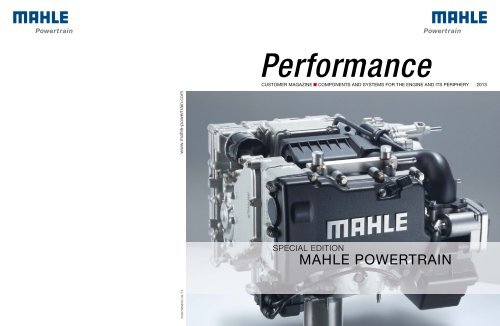
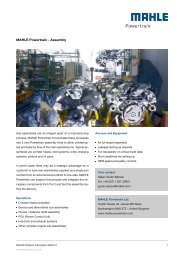
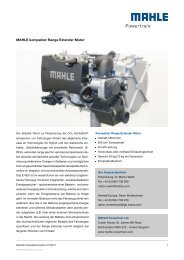


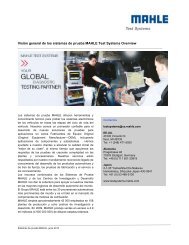
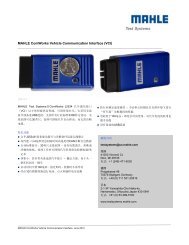

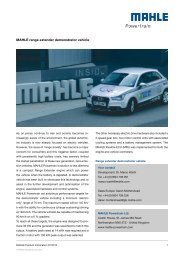
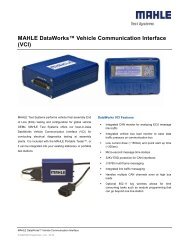
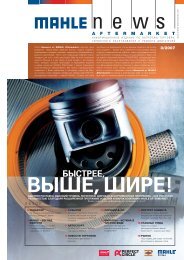
![[PDF] Dust collector SFR-08 - mahle.com](https://img.yumpu.com/37394977/1/184x260/pdf-dust-collector-sfr-08-mahlecom.jpg?quality=85)
